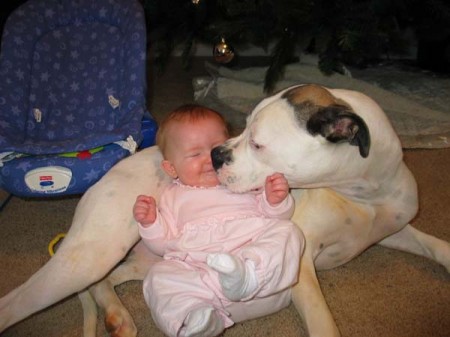Dog bite prevention and children

While more children are killed each year by their own parents than by dogs, dog bites definitely occur. They are always a result of either the dogs handler or the child’s parents (sometimes both). Neither the dog nor the child can ever be blamed.
True story: child sees dog, child walks up to dog, child hugs dog, dog bites child, everybody freaks out, dog is euthanized.

So what exactly happened here? Was the dog a monstrous beast that deserved to be killed? Did the dog bite without reason? No. The dog bit because she felt threatened when the child invaded her space. This certainly doesn’t make it okay, but it helps explain what happened. Too often the dog and sometimes her handler will be given sole blame in a situation such as this, and that’s simply not fair. While the handler should certainly be investigated, so should the parents of the child (who often get off scot-free)! These situations can usually be avoided if the parents take the time to properly educate the child in the first place.
What follows are common reasons and situations in which children get bitten, so you as a parent can take appropriate measures in educating and supervising your child.
Children that approach unknown dogs
A child should be taught never to approach a strange dog without permission from the owner, and not without adult supervision. Chances of a bite dramatically increase should the child embrace and hug the dog, since this is not a natural way for dogs to greet - and unless socialized properly - be interpreted as a threat.
Children’s eye contact can be threatening
Since young children are not very tall, their eye level is much closer to that of the dogs’ eyes than in the case of an adult. Since staring directly into a dogs eyes can be perceived as a threat, the chances of a bite is increased. Always teach your children not to stare at the dog for long periods of time. Instead look for a few seconds, then look in a different direction, and then back at the dog. Repeat. This signals that you are not a challenge and will decrease the likelihood of a bite.
Children run a lot
Since children often run around and are generally fast paced, some dogs can become startled and/or threatened by this and act accordingly. This can also activate the prey/chase instinct in certain dogs, making it all that more important that children are taught to thread carefully when first meeting a strange dog. There’s always time for running later.
Children can hurt dogs
Children sometimes unknowingly hurt dogs. Whether it be through tugging on a tail or poking an eye ball, the risk of a bite is increased. Teach your children to be careful with sensitive areas.
Children are loud
Children have high pitched voices, and especially when yelling, can easily startle a dog into feeling threatened (even more so if the dog is sleeping). This can in turn result in a protective and/or instinctive bite.
Children don’t always respect sleeping dogs
Suddenly waking a dog that is sleeping can result in a bite because the dog might feel startled. Children should always be taught to respect a dog that’s sleeping. Dogs need rest, too.
Children who don’t respect the dogs personal space
Socialized dogs usually love to play with children, but if your dog has a special part of the house (or a crate) that’s just his - a place he goes to rest - then that place should be respected as such. Teach your children to recognize when the dog is asking for rest, and to respect that request.
There’s much more that could be said about children and dogs, but the takeaway is this: dogs and young children cannot be blamed for what happens between them. That responsibility lies solely with the handler and the parents. So the next time a dog bites a child, stop blaming the dog and look at the real reason behind what happened!
Comment on this article